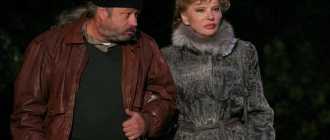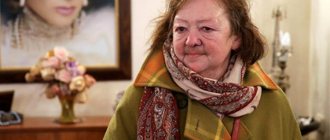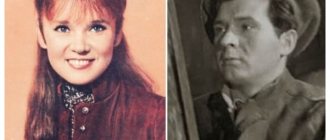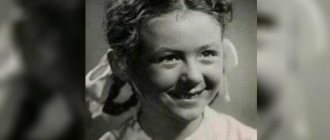Journalism student and theater actress at Moscow State University
Iya Savvina in the theater dressing room. Photo: 24smi.org
Iya Savvina was born on March 2, 1936 in Voronezh. Her parents soon divorced, and the future actress was raised by her mother, Vera Kutepova. In 1946, they moved to a village near Voronezh: Kutepova was sent there to work as a village doctor. Iya Savvina attended a local school. She liked literature, and Savvina dreamed of becoming a teacher.
Savvina graduated from school with a gold medal, and she had a chance to enter Moscow State University. However, when she reached the capital, the acceptance of documents for the philology department had already been closed. It was possible to apply to the Faculty of Journalism, which in those years had just separated from the Faculty of Philology.
The competition was difficult, there were 13 medalists for one place. Many could not answer additional questions, but Savvina was lucky. The examiners drew attention to her unusual name - translated from Georgian it meant “violet”, and then asked a formal question about her favorite poet. Savvina read Mayakovsky, and the next day she saw herself on the list of those enrolled.
Iya Savvina has been interested in theater since school, and at the university she combined her studies with classes in a drama club. In 1955 she played in the amateur play “Mashenka”. After which I decided to go to the Moscow State University Student Theater, which already in those years staged performances on a par with professional groups. At first she served as a costume designer there, and then began auditioning for small roles. At rehearsals, Savvina met hydrogeologist student Vsevolod Shestakov. They got married, and in 1957 a son, Sergei, was born into the family. However, the marriage soon broke up.
In 1958, when they were selecting actors for Rolan Bykov’s new play “Such Love,” the head of the group, Konstantin Lipsky, recommended Savvina for the main role - Lida Matisova.
The play “Such Love” was born at the turbulent turn of time, at the rise of social life; then poets' evenings began to be organized at the Polytechnic, Efremov managed to create Sovremennik, new names appeared in directing. A young actor from the Moscow Youth Theater, Rolan Bykov, was invited to MSU and found like-minded people in our team. “Such Love” was reviewed by the whole of Moscow.
Iya Savvina
In 1958, Iya Savvina graduated from the Faculty of Journalism, defended her diploma on the topic “Television programs on literature and art” and for some time worked in her specialty - in publishing and on television. The actress recalled: “After graduating from university, I had to work in Detgiz, and I was glad of this opportunity, because I adore children’s literature, I “swallow” all new items.”
Working on television
Iya Savvina (the artist’s biography and personal life were regularly discussed in the media) has worked a lot in this area. She was the author and presenter of a number of television programs about Russian writers: Saltykov-Shchedrin, Ostrovsky and Turgenev. In addition, Iya Sergeevna wrote several film studies notes about the work of L. Orlova, F. Ranevskaya, N. Urgant, M. Ulyanov, S. Yursky and others. Under her auspices, talented Moscow actors of different generations acted in films and first-class television workers worked at the head with director Thorstensen.
"Lady with a dog"

Iya Savvina as Anna Sergeevna and Alexey Batalov as Dmitry Gurov in the feature film “The Lady with the Dog” by Joseph Kheifitz (1960)
After the play “Such Love,” the graduate of the journalism department began to be invited to play in theater and cinema, but she did not agree: she wanted to work in her specialty. But she couldn’t refuse the leading role in “The Lady with the Dog,” based on the story by Anton Chekhov. Alexey Batalov called Savvina to the shooting - he noticed the actress at the production of “Such Love” and suggested that she come to the audition. Director Joseph Kheifits decided that Savvina would be perfect for the role of Anna Sergeevna von Diederitz, “the lady with the dog.” They were surprised at this appointment. Lyudmila Gurchenko recalled: “Personally, I was sincerely upset that such an inconspicuous girl was taken as a “lady.” Savvina later wrote that working on “The Lady with the Dog” took a lot of energy from her. There was no theater education and I had to learn acting right on the set. She said: “I am the best actress among journalists.”
Many scenes from the film were filmed on the Yalta embankment. Decorators installed a wooden copy of an ancient cast-iron fence here. The filming took place in the morning, at dawn: at that time there were almost no vacationers here.
The film premiered in January 1960. The film was also shown at the Cannes International Film Festival - the jury awarded the film the prize “For Humanism and Exceptional Artistic Quality,” and Savvina received a special award for Best Actress. The film was also noted at other competitions: “Jussi” in Finland, and the International Festival Film Review in London. Alexey Batalov and Iya Savvina became famous in the country and abroad.
1980s
This decade was not very fruitful for the actress. Iya Savvina, whose personal life did not interfere with her work, starred in nine films. The most notable projects were the tragicomedy “Tears Dropped,” the film story “Our Calling” and the drama “Three Years.”
I would also like to mention O, which was directed by Yuri Raizman in 1982. Iya embodied the image of Abrikosov’s wife Natalya Ilyinichna. The main character of the film, who works as a director of an enterprise, is soon to retire. Only now he realized that he practically did not know how to live an ordinary life, finding himself “out of work.” Loneliness, jealousy and pity for his loved ones force him to reconsider his priorities and try to change everything... The film received many nominations and prizes at the Moscow and Venice festivals.
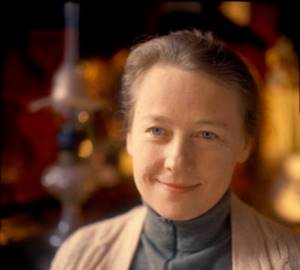
“Nora wishes Nora success”: roles at the Mossovet Theater

Iya Savvina as Farry and Faina Ranevskaya as Ethel Savage in Leonid Varpakhovsky's play The Strange Mrs. Savage. 1965. Mossovet Theater, Moscow. Photo: f-ranevskaya.ru
In 1960, Yuri Zavadsky invited Iya Savvina to the Theater. Mossovet, where she made her debut in the play “Nora” based on the play by Norwegian playwright Henrik Ibsen. Later, the actress recalled that she was very worried before the premiere: “With the concerns of the theater, the first performance was framed as an event. There were also special posters with large headings: “Debut of the artist Iya Savvina” (when I saw it, I almost died of fear).” After the performance, Savvina received feedback from the famous actress Lyubov Orlova, who played this role before: “Nora wishes Nora success, good spirits, peace of mind. Then everything will be fine. Hugs. Lyubov Orlova. The play did not leave the theater's repertoire for many years.
Savvina, along with leading theater artists, began to be given leading roles in productions. In 1965, she played in the play “The Strange Mrs. Savage,” where her stage partner was Faina Ranevskaya.
This was the first meeting in which I was completely convinced that my partner was smart and talented. For me, my partner is the most important thing. She [Iya Savvina] was so truthful, so convincing that it was difficult for me to imagine her differently. But then I remembered the captivating “lady with a dog” in the movie, I remembered a number of her other works in cinema and theater of a different kind, and it became clear to me that I had met a great actress of great talent, and I was very happy about it...
Faina Ranevskaya, “Fate the Whore”
In 1969 at the Theater. The Moscow City Council hosted the premiere of the play “Petersburg Dreams” based on the works of Fyodor Dostoevsky, in which the actress played the role of Sonya Marmeladova. The poet Pavel Antokolsky, who attended the production, dedicated the poem “Sonechka Marmeladova” to the actress. Ia Savvina":
Under the drunken hubbub, din and boom, Under the cries of base slander, - For the audience, for everyone else, She herself is the brightest light. She came on stage, as if to a temple, without preparing for a high role, in order to set her own price on Dostoevsky, on conscience.
At the same time, Savvina continued to work in films: in 1967 she played Dolly Oblonskaya in Anna Karenina and starred in Andrei Konchalovsky’s film The Story of Asya Klyachina, Who Loved but Didn’t Get Married. Savvina called these roles the main ones in her career. The actress wrote: “I have always dreamed of playing a woman who resists circumstances. Such is my peasant Asya, such is Princess Dolly - the ideal of Tolstoy’s woman. They are dear to me as prototypes, and I am indebted to them as an actress.”
“He brought men and women and forced him to talk to them.”
But the actress did not refuse film roles. After filming “The Lady with the Dog,” she began to receive offers from different directors, and the heroines she was offered to play were as different as possible from each other. But Savvina always managed to find an approach to them and play in such a way that the most picky critic said: “I believe!” The peak of her film career came in the 60s: she starred in the films “The Meek” (1960), “The Sinner” (1962), “They’re Ringing, Open the Door” (1965), “In the City of S.” (1966), “Anna Karenina” (1967).

PHOTO: Valentin Mastyukov/TASS
One of the most significant and difficult roles of that period for Savvina was the role of Asya in Andrei Konchalovsky’s film “The Story of Asya Klyachina, Who Loved, but Didn’t Get Married” (“Asia’s Happiness”). At first, the actress did not believe that she would be able to realize the director’s idea, and Konchalovsky himself doubted his choice.
“Konchalovsky just couldn’t find an artist. Then I came to the file cabinet, where all the photographs were. He looks at the photographs and is told: “Try Savvina.” - “Savvina, the lady with the dog? Are you crazy? And then he says: “This is the face I need. Such a white bone." Everyone laughed: “Look what’s written on the back,” the actress recalled with a smile.
In his film, Efremov decided to use not professional actors, but ordinary people from the village. But he never found the leading actress among the peasants. Then the director remembered Savvina again and decided to give her a test.
“I came, he brought men and women, as we call them, whom he selected and forced to talk to them. The next day I told him as I was leaving: “I won’t audition, I won’t act.” - “Are you crazy, why?” “I can’t, I can’t work with them. I’m already covered in some sort of acting scab, and these are real people. There’s no way I’m going to fit in with them.” - “No, no, no, I’m trying you.” He just forcibly arrived at 9 am. I lived then on Frunzenskaya Embankment. He took me by the collar, put me in the car and brought me to the site, and we tried out.
It was very difficult. I don’t know if it worked or didn’t, but I tried. Under no circumstances should they be imitated. You had to feel them, absorb them, because when a person starts imitating someone, it’s a dead act. This is already a failure, this is no longer true. I in no way imitated them, these wonderful people, but tried to absorb them. Maybe the fact that I’m from the countryside helped me,” recalled Iya Savvina.
“Winnie the Pooh and everything, everything, everything”: dubbing the cartoon

Iya Savvina. Photo: nastroenie.tv
In 1969, Iya Savvina was made an unusual proposal. Director Fyodor Khitruk invited me to work on a new cartoon based on Boris Zakhoder’s book “Winnie the Pooh and Everything, Everything, Everything.” Zakhoder was her son’s favorite writer, the actress knew his work well, and she even read “Winnie the Pooh” by heart.
At that time, all the understudies had already been recruited, but problems arose with voicing Piglet: none of the applicants suited Khitruk. When the director heard Iya Savvina’s voice, he immediately offered her this character.
Winnie the Pooh's remarks were read out by Evgeniy Leonov. The actress often recalled comical cases when Leonov, concentrated and tragic, like Hamlet, said in front of the microphone: “Isn’t it time... to refresh yourself?” or “Where Piglet and I are going is a big, big secret.”
Piglet Iya Savvina decided to voice the hero in the style of Bella Akhmadulina’s speech. The actress loved listening to her performances as a poetess, and watched the film “There Lives a Guy Like This” with her participation. The cartoon character spoke in the same crystal voice and chanted the words in the same way. During editing, the recording was sped up and the tone was raised. Fyodor Khitruk later recalled: “It was a 100% hit!”
After the cartoon was released, Bella Akhmadulina called Savvina: “Thank you for giving me not a pig, but an adorable pig.”
Interesting Facts
- Once Fyodor Khitruk decided to film “Winnie the Pooh”. One of his acquaintances told him that Iya Savvina (biography, personal life, son of the actress - information about all these issues is presented to your attention above) loves this work very much. Khitruk immediately contacted her and invited her to audition. Savvina came, looked at the sketches and praised Leonov, who played the main role. But when Fedor invited the actress to participate in voice acting, she refused. Although she later stated that she would be happy to try it if a suitable prototype was found. A few days later, Iya called Khitruk and informed him that the search for a character for voice acting was over. So Piglet spoke in Savvina’s voice. Although the actress, like Leonov, had to be “accelerated.” It was not the text itself that was difficult, but the intonation. Iya was very worried and worried during the recording. Therefore, Khitruk recorded it at numerous rehearsals. Fyodor believes that Savvina’s Piglet was the actress’s greatest success.
- In 1994, Andrei Konchalovsky released the film “Ryaba Hen”. This film became a kind of continuation of the film “The Story of Asya Klyachina”. Twenty-five years ago, Iya Savvina (the biography and personal life of the actress was constantly discussed in the tabloid press) played the main role in it. But she refused to work with Konchalovsky. After reading the script, Iya considered it offensive to the entire Russian people. As a result, the image of Asya was embodied on the screen by Inna Churikova.
Savvina's roles at the Moscow Art Theater

Iya Savvina and actor and director Oleg Efremov. Museum of the Moscow Art Academic Theater, Moscow
In 1977, the artistic director of the Moscow Art Theater Oleg Efremov invited Savvina to join his troupe. “I came to work not at the Art Theater, but with Oleg Nikolaevich Efremov,” the artist later wrote. In this theater, Savvina made her debut in the play “Summer Residents” directed by Vladimir Salyuk. According to Efremov, she soon became one of the main actresses of the Moscow Art Theater and added a “pure, intelligent sound” to its productions.
...Having gone through a practical school, she actually excels not so much with her skill and sophistication, but with her rich intuition and talent, given by God. Iya Savvina is an actress who attracts people to her. Which is very important, simply necessary in the theater. You can talk about anything seriously with her. Argue seriously. And also seriously sit at the table. But above all for her is the Theater.
Oleg Efremov (based on the book “Booklet for the anniversary”)
On the stage of the Moscow Art Theater they staged performances with the participation of the actress: “So we will win!”, “Meeting of the Party Committee”. Savvina often played in productions based on Chekhov’s stories and plays - “Uncle Vanya”, “The Cherry Orchard” and others, and in 1981, together with other Moscow Art Theater actors, she recorded the radio play “The Seagull”.
In the 1990s, Iya Savvina took part in the “Chekhov and Co.” project, which was dedicated to the centennial anniversary of the Moscow Art Theater, and played in productions of “The New American” based on the works of Sergei Dovlatov, “Cat and Mouse” and others. For the main female role in the play “Christmas Dreams” directed by Pyotr Stein in 1999, the artist was awarded the Highest Theater Prize in Moscow - “Crystal Turandot”.
